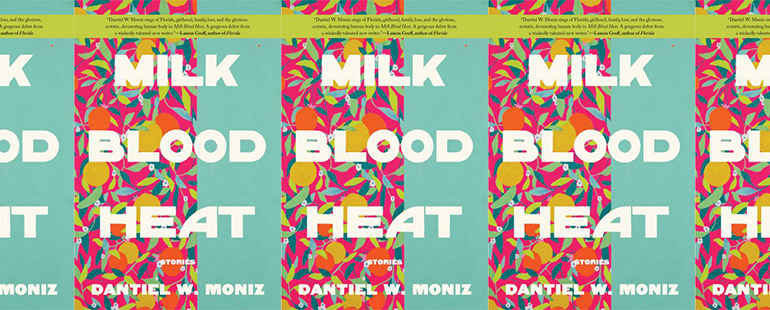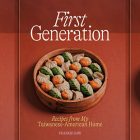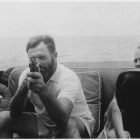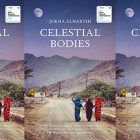Milk Blood Heat’s Dreams Lost

In Dantiel W. Moniz’s debut collection of short stories, Milk Blood Heat (2021), we see characters with deep imaginations, deep dreams, deep connections with their loved ones. The stories are almost exclusively set in Florida, and rarely move from their original physical setting (or at least the orbit of it), but this fact doesn’t change how the physical surroundings of these characters often differ from what they imagine, from what they dream with their loved ones. The characters in these stories, like so many people, build a language, a world, a home through inside jokes, through imagining lives together, through love. But in Moniz’s collection we see how characters deal with the losing of the people they share this home with, and how the subsequent isolation and retreat to the worlds in their heads forms a connective tissue with the loves they’ve lost—and can result in the losing of oneself.
Moniz’s collection opens with the title story, “Milk Blood Heat” (which first appeared in Ploughshares’s Spring 2018 issue, guest-edited by Lan Samantha Chang). In this story, we follow Ava and Kiera, two young girls who are growing up together in Florida. Early on, Ava talks about how she is starting to see in dualities. She talks about how she has become obsessed with “looking at one thing in two ways: Kiera’s eyes, strange and magic; her own sadness, both imaginary and pulsating.” This speaks to how imagery, when used to play the what if game, becomes a part of their world.
The story opens with the girls at Kiera’s house, because at that house they believed in “freedom of expression,” whereas at Ava’s house, they were viewed as “tomboys” and “lazy.” This attitude was stifling to Ava; it felt like she was given access to a whole new world when she met Kiera. She describes this when she talks about how they first became friends, when Kiera approached Ava and mentioned how she felt like she was “drowning, and though there was no water in sight, Ava knew what she meant.” This moment shows how the girls had tapped into their imaginations, and through their friendship could go beyond the world that they were otherwise confined to. The world is hard, and the first person that Ava met that saw the world the way she did, and vocalized it, making it all the more real, was Kiera. We see how the girls continue to imagine a world that they can live in, manipulate into their own, when Ava talks about how “She throws her head back and howls and howls at the sun, pretending it’s a strange, burning moon, and that there is no other world than this one where she and Kiera are.” Just like that, Ava is in a world that is her own, a world where she isn’t viewed as lazy, or criticized for dressing or acting “incorrectly.” Kiera’s friendship and validation make it possible for Ava to feel completely at home.
Later in the story, we see the girls playing the what if game, where they imagine and hypothesize all the different routes their lives can go. They play out all the scenarios in their head without the typical restrictions put on girls (and, in Ava’s case, the extra restrictions put on Black girls). Ava also asks dark questions: “What If I step in front of this car, right now? What If I don’t wake up tomorrow?” Kiera plays the game like “she has nine lives.”
Ultimately, Kiera imagines what it would be like to float off the roof where she and Ava sit like the paper plate she had just thrown; then, she follows it. This moment begins the part of the story, of Ava’s life, where the potential of her world, of her life, goes from expanding through imagination to closing in on her. She sees the empty sky, and she catches her feet moving “without her consent as two contrary wants rise up inside her: the want to run, and also to see everything.” No matter how strong their ties were, no matter how strong their imaginations were, they still were tethered to the realities of this world, a world that was now absent of Kiera.
The questions Ava faces after Kiera’s death—from parents, police—are all questions with answers that are more restrictive, that cement a legacy, a life, than open up its potential. The questions ask, “Was it something we did? Was she mad at us? How could this happen?” Ava later says that the one answer she withheld was the one that they couldn’t come to grips with: that Kiera just wanted to see how it felt. Throughout the rest of the story, we see how Ava struggles with the idea that Kiera has felt something that Ava hasn’t yet, can’t yet. And then she realizes the reverse: Ava is living a life without her best friend, experiencing things first and forever alone from then on out.
Ava eventually wins out over the trauma of Kiera’s dead body, of the finality and all-encompassingness of it, and she starts to remember things about Kiera from before her tragic death that ended all the potential, all the imagination tied to her. And Ava starts saying that Kiera died drowning, like the first “death,” or dream, or imagination, they shared together, allowing Kiera to own her own death a little bit, and allowing Ava to have one last inside joke with her friend.
At the end of the story, we get a flashback to Kiera’s fourteenth birthday, her first since her death. Ava walks to Kiera’s backyard, the place where they had imagined too many lives and worlds for them to live in, and Ava notices Kiera’s mother sitting there, alone. Ava places her body against Kiera’s, hoping that her mother could feel a bit of Kiera in her best friend, and hoping that in doing so, Ava could share another moment with her friend, cause that’s the only way she’ll feel at home.
In another of Moniz’s stories, “Feast,” we see the bond breaking between the main characters, Heath and Rayna, and how that results in Rayna’s struggle to survive after a miscarriage, a situation that is so often silenced by our society.
On the first page of the story, we see how Rayna assumes Heath envisions her to be, which doesn’t square with how she feels about herself, or who she will grow into. Heath tries to comfort Rayna after she wakes him up by calling his name, saying she was just dealing with a nightmare. Rayna notes to herself how she doesn’t “correct him, don’t mention the tiny hands that are still climbing up and down the drapes. We are both pretending. It’s the only way we sleep.” In losing the baby, Rayna has lost the being she felt the most connected to, who she loved the most, before they could even share a moment in this world.
We thus start “Feast” with Rayna and Heath not connecting, and the world that Rayna lives in within her own head is one that is isolating and terrifying for her. She ends up locking herself in her bathroom “with the baby books, flipping through them carefully, and nowhere was it written how to reverse time or spark a heartbeat. How to make a womb worthy.” Rayna is struggling, isolating herself; the world she is trying to build in her mind is failing her, and she is not getting any help to stave off the demons, so she only further isolates herself, further hurts herself.
Rayna explains how she first saw the baby in a gift of marigolds that Heath had bought for her. She explains how she was “afraid to blink, in case it disappeared. She was with me, talking to me, which meant maybe I could talk back.” Similar to “Milk Blood Heat,” the disconnect here between the living and the dead wears on Rayna, as, like Ava, she starts to feel like she’s let down the baby she loved and has been left behind by her too.
Rayna struggles to keep her head above water, though she admits that she didn’t “tell Heath; this was for me, and I didn’t need a psychiatrist to understand what these visions were—a reminder of how the baby would have developed if she were still safe inside of me.” Because Rayna feels isolated, has no one that is connecting with her, she feels like “a dead satellite, picking up information but not relaying anything back.” Rayna is feeling herself get eaten up by the outside world, but also by her own thoughts. She “can’t pretend that I’m ok . . . There is no make-believe that makes me less horrible.” These thoughts contribute to her eating herself more and more, for she is isolated and can’t find any reprieve—from her loved ones, from the doctors, from the real world, from the world she has built inside her own head.
In a world that continues to be more and more isolating, with the COVID-19 pandemic entering its third year, so many of us have lost people, and haven’t been able to properly mourn them. In a world where people have to work more and more just to make ends meet, where more and more people are “connected” online but otherwise isolated from the rest of the world, so many of us have lost touch with people we’ve loved, whether due to death, them moving away, or our not being in our peoples’ lives every day. We have seen the importance of the friends and loved ones you can keep, the ones you have a mental, a spiritual connection with. The ones you build a home with, a life with, that can’t be physically taken away. Reading this book, where so many characters deal with the loss of the people they’ve built their homes with, I see a reflection of what so many of us have been going through, in one degree or another. We’ve seen how home doesn’t feel like home without the people you love the most in it, for these connections are important to everybody—they’re important for all of us to be able to be at peace with our own minds, with the love we share with humans on this earth, that we hold onto, even after the people we love and have built a home with are taken away. In an unfair world, we often catch ourselves losing the people we need the most, losing them right when we need them, and the home and the life we’ve built with them, the most. So we all have to do our best to keep living our lives, their lives, with them, for them, for us.



